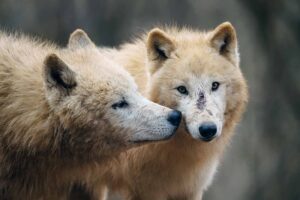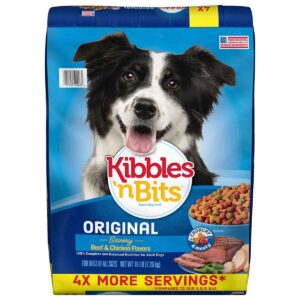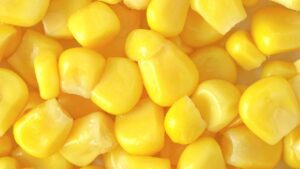You’ve probably been hearing lots about “fresh” dog food lately.
Invariably, the main pitch is that kibble’s ingredients are low quality, and processes are harsh. How true is that? Our multi-part series investigates.
Starting with the cheapest dry foods available today.
Not all kibbles, or dry dog foods, are created equal. There are some out there that do pass some quality tests. You can check out our multi-part series where we try and look at the full spectrum of kibbles. For this article however, we’re going to focus on the cheapest dry foods available, and investigate how they manage to achieve that price point through their ingredient panel, and the manufacturing processes they need to make these ingredients into their final form.
At the bottom of the kibble spectrum, we see many common low quality elements. The first theme you’ll notice is that meat is never a #1 ingredient. The reason is very simple: Meat, even as a by-product, is expensive.
While it is technically true that dogs are omnivorous, most veterinarians will tell you dog food of any type should start with meat as the #1 ingredient. Omnivores, are of course able to eat and remain healthy with both animal and plant-based foods. Studies have shown this is mostly true for dogs, but unfortunately this finding has been stretched by the dog food industry. The result has been the overuse of plant based materials as primary protein sources.
Dogs are not true omnivores like humans are.
If empirical evidence of what a dog prefers is ever needed, try offering a vegetable in one hand and a meat product in the other. Dog’s prefer meat. Thankfully for our wallets, they can also ingest and utilize plant nutrients as well. But as you’ll discover below, low-end kibbles take this fact to its unfortunate extreme.

Arctic Wolves. Photo by Lubos Chlubny
Dogs are perhaps closer, and many still consider them to be, “facultative carnivores“. A facultative carnivore can ingest and use some non-animal foods, but not nearly as well as a true omnivore. Wolves are considered facultative carnivores. Domesticated dogs land somewhere in the grey between the two classifications.
The confusion goes in the other direction as well. Sometimes dog’s will be described as being “obligate carnivores” which is incorrect. You’ll find this in many foods promoting themselves as nearly “all meat”. Obligate carnivores are species who’s diets must consist of 70+% of meat, because their digestive tracts are unable to process most plant materials. Lions, Tigers, and even house cats fall into this category. Dogs and wolves do not.
What qualifies as meat in these kibbles is dubious at best
The next theme you’ll notice is that the “meat” content that does appear in low end kibble, is of incredibly low quality. “Meal” of varying types is usually the only meat ingredient. Meat and bone meal is a by-product produced by quite literally sweeping the slaughterhouse floor. Animal parts of almost every type (hair, hooves, blood, & contents of the digestive tract are the only things legally off limits), are ground into a powder and sterilized using ultra-high heat. Super high heat is needed because even diseased and spoiled meat is legally permitted to be utilized in meals.
An environmental point should be made here: This article does not aim to condemn all use of meal. It is an objectively good thing to utilize as much of an animal raised for food as humanly possible. There’s not much demand for most of these animal parts individually. Things like brains, eyeballs, carcasses, organs etc., they all have nutritional value. Combining all of these things makes them commercially viable. Unfortunately, the high heat required to make this product somewhat safe, negates many of the nutritional qualities. But at least it is utilized. Meal should not, however, be the primary meat source of any dog food product.
Completely artificial ingredients are scarily close to the top of the ingredients list
The third and perhaps most dubious theme you’ll notice, is that many chemicals and completely artificial ingredients are needed to produce some of these kibbles. They are often needed to make the food in any way palatable to dogs. Many have detrimental health outcomes associated with them.
Let’s look at a name brand we’ve probably all heard of:
 Kibble’s n’ Bits
Kibble’s n’ Bits
Produced by: Post Holdings
At the time of this writing, a 16lb bag costs a shockingly low $13.49, less than $0.85 per pound of food. The marketing might get you to believe that this is a balanced diet for your dog. The ingredient list tells a very different story. We’ll only focus on the first few ingredients, as those make up the vast majority of the content. It’s also important to point out that while we are dissecting this particular brand, many in the same price range are similar. Examples include: Alpo, Ol’ Roy, Gravy Train, and Pedigree to name a few. Here’s the full ingredient panel of today’s focus: (all 46 of them!)
Corn, Soybean Meal, Beef & Bone Meal, Ground Wheat, Animal Fat (BHA Used As Preservative), Corn Syrup, Wheat Middlings, Water Sufficient For Processing, Animal Digest (Source Of Chicken Flavor), Propylene Glycol, Salt, Hydrochloric Acid, Potassium Chloride, Caramel Color, Peas, Sorbic Acid (Used As a Preservative), Sodium Carbonate, Minerals (Ferrous Sulfate, Zinc Oxide, Manganous Oxide, Copper Sulfate, Calcium Iodate, Sodium Selenite), Vitamins (Vitamin E Supplement, Vitamin A Supplement, Niacin Supplement, D-Calcium Pantothenate, Riboflavin Supplement, Pyridoxine Hydrochloride, Thiamine Mononitrate, Vitamin D3 Supplement, Folic Acid, Biotin, Vitamin B12 Supplement), Choline Chloride, Calcium Sulfate, Wheat Flour, Carrots, Green Beans, Titanium Dioxide (Color), Yellow 5, Yellow 6, Red 40, BHA (Used As a Preservative), Blue 1, DL-Methionine.
#1 ingredient: Corn
 We quickly see how Kibble’s and Bit’s misses the protein mark here. Corn, thankfully for the pups who have to eat this, is actually absorbed fairly well in canines. What little nutritional value it does provide, the dog absorbs it. But it’s not included here for its exceptional nutritional value. It’s here for one reason and one reason only: cheap calories.
We quickly see how Kibble’s and Bit’s misses the protein mark here. Corn, thankfully for the pups who have to eat this, is actually absorbed fairly well in canines. What little nutritional value it does provide, the dog absorbs it. But it’s not included here for its exceptional nutritional value. It’s here for one reason and one reason only: cheap calories.
Because of its low cost, and dog’s ability to process it, it has tended to make up a relatively high proportion of low-cost brands of dog food. Detriments of corn include having a relatively high glycemic index, not being greatly digestible, and having an overall low nutritional value when compared to most other grains, and certainly to meats. When stacked with corn syrup, which appears as the #6 ingredient here, this could be a recipe for diabetes and other health issues.
#2 ingredient: Soybean Meal
Soybean Meal as the second most abundant ingredient, does not do this food many nutritional favors. This meal is a by-product derived from the grinding, heating, and extraction of soybeans.

Soybean meal is a principal source of protein for the livestock industry worldwide. It is also used in many companion foods, as we see here. The meal is used because, you guessed it: it is cheap.
Thankfully, like corn, soybean meal does have some nutritional value for your dog: Soybeans have a high energy content, as well as being a protein source. They also contain essential fatty acids (linoleic acid, mainly) Lecithins also appear in soybeans, which are essential to your dogs health. (luckily lecithins are in meat sources as well).
That’s about where the superlatives of the ingredient stop, however.
Unfortunately due to the processing (high heat), many of the benefits of soybeans are reduced when presented as a powdered meal. Soybean meal contains several anti-nutritional factors, things which are not digested by dogs.
Production of soybean meal also involves extrusion, another high heat process that can denature its proteins and compromise amino acid bioavailability. Soy meal has been shown to cause gastrointestinal discomfort (flatulence), and contribute to the formation of low-quality stools. It also reduces palatability and digestibility of the food.
That’s a whole lot of fancy words to essentially say: Feeding soybean meal as a main protein source makes your dog fart more, poop more, and gain less energy than most other protein sources. Your dog isn’t livestock, but low-end foods like this treat them as such.
#3 ingredient: Beef and bone meal
The next ingredient is beef and bone meal, finally getting the word beef in there. But even that language is slightly disingenuous. That’s because the true name of this ingredient is MBM (meat and bone meal). MBM is a product of the rendering industry composed primarily of the offal (internal organs), bones of slaughtered livestock, fat from unmarketable animal tissues, unsellable retail meat products, and whole condemned carcasses (excluding hair, blood, hooves, horns, and contents of the gastrointestinal tract).
 While that definition includes lots of gross stuff, it’s not all bad. Organ meat of many kinds tend to be highly nutritious, more nutrient dense than even muscle meats, and should be a part of every dog’s diet. They shouldn’t however, make up the majority of the meat content, which clearly here in MBM, it is. “Meal” of any kind always involves lots of high heat processes to get it into its final form, which negates many of the nutritional benefits associated with some of these animal parts.
While that definition includes lots of gross stuff, it’s not all bad. Organ meat of many kinds tend to be highly nutritious, more nutrient dense than even muscle meats, and should be a part of every dog’s diet. They shouldn’t however, make up the majority of the meat content, which clearly here in MBM, it is. “Meal” of any kind always involves lots of high heat processes to get it into its final form, which negates many of the nutritional benefits associated with some of these animal parts.
We are through the three main ingredients, and haven’t described much that sounds like staple ingredients. In Good Pup’s ingredient panel the first three ingredients make up around 70% of the contents. While it is impossible to say what percentage these first three ingredients in Kibbles and Bits amounts to, it is probably safe to assume it amounts to a near majority.
Feeling hungry yet?
This article would be a 100 miles long if we were to scrutinize line by line every ingredient, so let’s only quickly address a few more, still going in order of quantity:
- Ground Wheat
- Code word for: Flour. A carbohydrate, contains some protein. Ground wheat should not make up any significant portion of a dog’s protein source.
- Animal Fat (BHA Used As Preservative):
- While dogs do require fat in their diet, this is NOT the best way to deliver it. BHA has been shown in clinical trials to cause cancer in lab animals. BHA appears twice in this ingredient panel.
- Corn Syrup
- While not technically toxic to dogs, corn syrup of course has a very high sugar content and is quite unhealthy, especially when eaten repeatedly over time. Corn syrup is only included for palatability, but can cause obesity and diabetes, just as it does in humans.
- Wheat Middlings
- Worse quality than the ground wheat above, middlings are quite literally the sweeping off the floor of manufacturing plants. While there is some nutritional value in the ground wheat, middlings are much more approaching “filler”.
- Water Sufficient for Processing
- This means they needed to add water to these ingredients because they didn’t have enough moisture content on their own to turn them into kibble pellets. It’s obvious to see why, when you dissect the top ingredients. most everything is a dry powder or pellet.
- Animal Digest (Source of Chicken Flavor)
- A digest is an additive made up of animal tissue. It is essentially a concentrate that has been treated with heat, enzymes, or acids to achieve a “natural flavoring”. Pet food may legally be labelled as “Chicken Flavored” regardless of the percentage of chicken-derived product it contains, so long as it does include chicken animal tissue amongst its contents.
We could go on…
…but with the next “ingredient” being Propylene Glycol, a controversial preservative, we are approaching things that almost certainly constitute <1% of the product. Two supplements for essential vitamins and minerals are added to this food as the 18th and 19th ingredients, well below even hydrochloric acid… yes, the same stuff Walter White dissolves entire people in.
This is a low quality diet for any animal, but especially your best friend. We’ll admit, these brands are an easy target to pick on. If you are considering adding something like Good Pup to your pet’s meal, we’re sure you were aware of how poorly this food would stack up against something like a fresh food. There’s no comparison. Unless there was a reason to non-sarcastically compare livestock feed to a health conscious restaurant’s options.
Keep reading to see how some of the better kibbles stack up! Where the contrast isn’t quite so stark. Read how you can supplement Good Pup with a high quality kibble to help keep costs down, while still offering a high quality diet to your best friend. Or if you want to read about the nutrition profile of what Good Pup offers, you can always learn more by clicking around this site.
Sources:
1:https://www.akc.org/expert-advice/nutrition/corn-in-dog-food-what-you-need-to-know
2: http://www.australianoilseeds.com/__data/assets/file/0019/1198/Sarah_Willis-The_Use_of_Soybean_Meal_and_Full_Fat_Soybean_Meal_by_the_Animal_Feed_Industry.pdf
3: https://www.ncbi.nlm.nih.gov/pmc/articles/PMC8158863/
4:https://nutrition.ansci.illinois.edu/node/573

